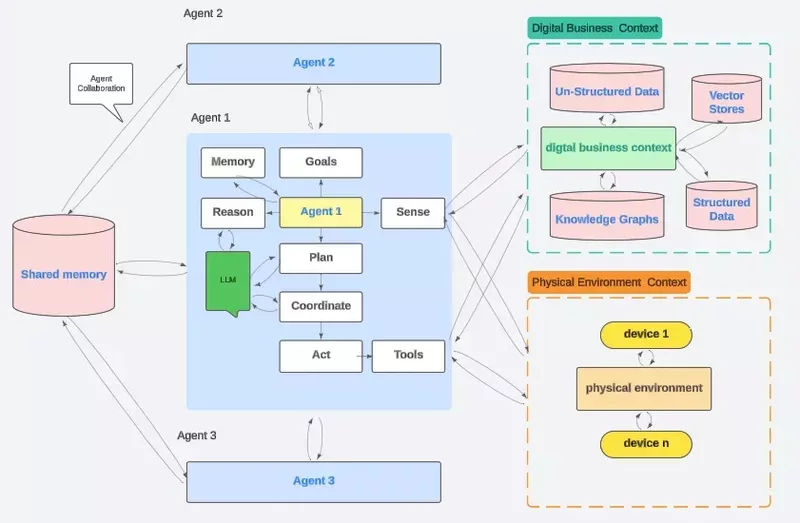
This article was originally posted on Medium.
In this article we will elaborate on the anatomy of agentic AI and how it operates.
The diagram below illustrates a multi-agent system architecture for agentic AI, where multiple agents collaborate to achieve a common goal within a business and or physical environment context. The key components and technical details are as follows.

Core Components
In the architecture of agentic AI, the primary building blocks are the agents, and the business or physical environments they interact with. Each agent operates (semi-) autonomously, perceiving its environment, reasoning about its circumstances, making decisions, and taking appropriate actions. These agents interact with both digital and physical environments to achieve specific goals. Central to this system is the shared memory, a repository that allows for seamless communication and coordination among all agents. This shared memory serves as the hub where information, plans, and goals are exchanged, ensuring that each agent can contribute to and benefit from the collective knowledge and strategies.
Agent Anatomy
Each agent possesses a detailed internal structure that allows it to function independently yet collaboratively within the system. The agent’s memory is a critical component, storing its individual knowledge, past experiences, and belief states. This memory provides the historical context and learning necessary for informed decision-making.
Agent 1 Anatomy
The key components of multi-agent systems are summarized in these verbs:
- Goals: objectives or desired outcomes it seeks to achieve.
- Sense: Gathers information from the business environment context. Also termed “perceive” or “perception.”
- Reason: Processes the sensed information to derive insights, uses the internal language model to interpret the relationship between goals, perception, collaboration, execution, and outcomes.
- Plan: Devises a course of action based on the reasoned insights.
- Coordinate: Interacts with other agents through the shared memory to align actions. Negotiate is a related verb but we will discuss this in detail in the patterns for agentic AI. Also Collaborate is used in multi-agent systems (MAS)..
- Act: Executes the planned actions on the environment.
- Memory: Stores the agent’s individual knowledge and experiences.
- LLM: Core to the “reason” component, responsible for processing and understanding language-based information within the environment and the shared memory.
Let’s examine this in a bit more detail.
The goals of an agent are defined as the objectives or desired outcomes it seeks to achieve. These goals are not static; they are dynamically updated based on feedback from the environment and the agent’s internal states.
Through the sense component, agents gather data from their surroundings. This sensory information can come from both digital sources, like data feeds, and physical sources, such as cameras or IoT devices. The gathered data is then processed by the reason component. Here, agents analyze the information using their stored knowledge and often leverage LLMs for complex language-based reasoning and inference.
Once the situation is understood, the agent moves to the plan stage, where it develops a sequence of actions aimed at achieving its goals. This planning is based on a reasoned understanding and situational context.
For effective operation within a multi-agent system, the coordinate component plays a vital role. It enables the agent to share information and align its plans with other agents through the shared memory, ensuring collaborative efforts toward common goals.
When it comes to execution, the act component is responsible for implementing the planned actions. Agents use various tools to interact with their environment, which could range from robotic arms for physical tasks to software interfaces for digital tasks. The LLM continues to support the agent by facilitating language-based reasoning and decision-making throughout these processes.
But without data, an agent cannot determine what to do next.
Data Stores
You can have multiple data repositories anddata sources comprised of a combination of:
- Unstructured Data: Raw data in various formats (text, images, etc.).
- Vector Stores: Store vector representations (embeddings) of (often textual) data for efficient similarity search.
- Structured Data: Organized data in databases or knowledge graphs.
- Knowledge Graphs: A structured representation of knowledge, connecting entities and their relationships. This provides a semantic understanding of the business environment.
Environment Contexts
Agents operate within diverse contexts. The digital business context encompasses all digital data sources relevant to the business domain. This includes unstructured data like text and images, structured data from databases, vector stores for embeddings, and knowledge graphs for semantic understanding.
In the physical environment context, agents interact with real-world elements through physical devices. These interactions are crucial for tasks that require direct manipulation of the physical world, facilitated by sensors and actuators embedded within the environment.
Interactions and Collaborations
The functioning of agentic AI involves several key interactions and collaborations. Agents continuously sense their environments, collecting data from both digital and physical contexts. This constant stream of information is critical for maintaining an up-to-date understanding of the surroundings.
Using this data, agents engage in reasoning and planning. They leverage LLMs to process the sensed information, draw inferences, and formulate plans. The result is a well-constructed set of actions designed to meet the agent’s goals.
Coordination among agents is achieved through the shared memory. This central repository enables agents to exchange their understanding, plans, and intentions, facilitating collaborative decision-making and coordinated actions. When agents act, they execute their plans by manipulating physical devices or interacting with digital systems as needed.
The system incorporates a feedback loop where the outcomes of actions are observed and fed back into the system. This feedback is used to update knowledge and refine future plans, ensuring that agents can learn from their experiences and continuously improve their performance.
Key Points
The architecture of agentic AI is characterized by several important features.
Modularity ensures that the system can add or remove agents without disrupting the overall architecture, allowing for flexibility and scalability. This design supports handling complex environments with multiple agents and diverse data sources, making the system highly scalable.
Adaptability is another crucial feature. Agents are capable of learning from their experiences and adjusting their behavior accordingly. This continuous improvement enhances the system’s efficiency and responsiveness over time.
The system’s ability to enable multimodal interaction allows agents to engage with both digital and physical environments seamlessly. This broadens the scope of tasks that agents can perform. Finally, collaboration is facilitated through the shared memory, leading to improved problem-solving and decision-making capabilities as agents work together toward common objectives.
How the Agentic AI System Works
- Sensing: Agents gather information from the business environment context through their respective “sense” components.
- Reasoning: Agents process the sensed information using their “reason” components, often relying on an LLM to understand and interpret language-based data.
- Planning: Based on the reasoned insights, agents formulate plans of action in their “plan” components.
- Coordination: Agents share their plans and relevant information through the shared memory in the “coordinate” phase, ensuring collaborative decision-making.
- Acting: Agents execute their planned actions on the environment through their “act” components.
- Learning and Adaptation: Agents update their individual memories and potentially the shared memory based on the outcomes of their actions, enabling learning and adaptation over time.
Technical Considerations
- Scalability: The system should be able to handle a growing number of agents and data sources.
- Communication Efficiency: Effective communication mechanisms are crucial for coordination between agents.
- Data Processing: Efficient processing of diverse data types (unstructured, structured, vectors) is essential.
- Knowledge Representation: Knowledge graphs play a key role in representing and reasoning about the business environment.
- LLM Integration: Integrating LLMs effectively for language understanding and reasoning is critical.
Conclusion
Agentic AI interactions involve the collaboration of communicating agents, each equipped with internal mechanisms for sensing, reasoning, planning, and acting. In MAS systems , these agents collaborate through shared memory, leveraging a variety of data sources and knowledge representations to interact effectively with both digital and physical environments.
Key takeaways include:
- Modularity and Scalability: Agentic AI systems are designed to be adaptable and can scale to handle complex tasks with multiple agents.
- Adaptability: Agents possess the ability to learn from their experiences and refine their behaviors over time.
- Multimodal Interaction: The capacity to interact with both digital and physical environments expands the potential applications of agentic AI.
- Collaboration: The shared memory mechanism fosters collaboration among agents, leading to more effective problem-solving and decision-making.
As research in this field continues to advance, we can expect agentic AI to play an increasingly significant role in bringing significant business transformation in various industries and application domains like finance, retail, healthcare, education, etc. The ability to integrate language models enhances the reasoning capabilities of agents, enabling them to understand and respond to complex instructions and situations.
The development of agentic AI marks a notable step toward creating intelligent systems that can operate autonomously, collaborate effectively, and learn from their interactions with the world. This holds the promise of revolutionizing numerous fields, from business automation to robotics and beyond.
Challenges remain in terms of scalability, ethical considerations, and the need for robust error handling, yet the potential benefits of agentic AI are substantial in driving positive business transformation. With ongoing research and development, we can anticipate a future where agentic AI systems become even more sophisticated and integrated into our daily lives, enhancing efficiency, productivity, and decision-making across a wide range of domains.